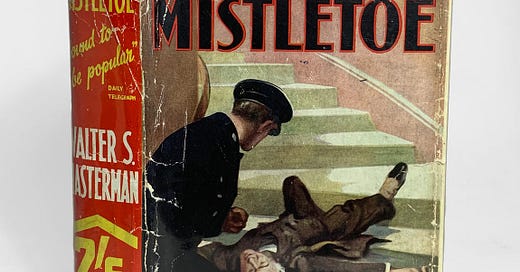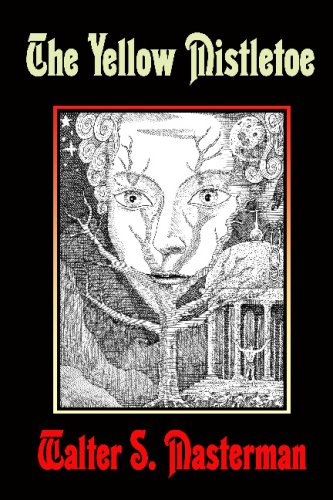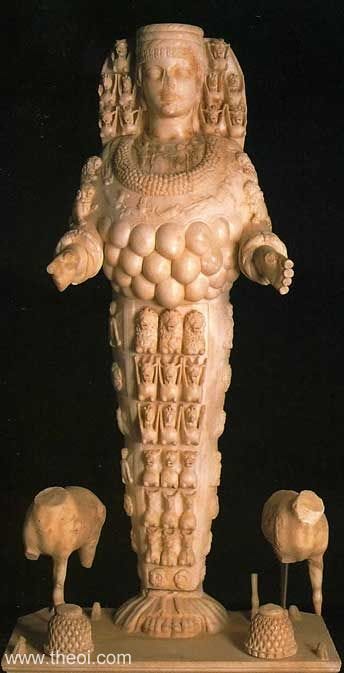Dearest friends!
It is once again time to pick apart another entry from Karl Edward Wagner’s much vaunted 39 List. The book in question, 1930’s The Yellow Mistletoe, was listed by Wagner’s as one of the “Thirteen Best Supernatural Horror Novels.” Its author, Walter S. Masterman, was apparently one of Wagner’s favorites, for the British scribe has two books on the 39 List (the other being 1932’s The Flying Beast). The novel itself is more mystery-thriller than horror, as a series of strange deaths form the nucleus of the story. That said, The Yellow Mistletoe does contain a weird element—its crescendo includes a secretive cult with ancient roots, a legend-haunted valley in the Balkans, and multiple scenes of ritual murder.
Grisly, no? But not supernatural. Once again, as with Doctors Wear Scarlet, our old friend KEW was off the mark.
Walter Sydney Masterman was born in the Wimbledon section of London during the very Victorian year of 1876. Well-educated and athletic (Masterman was a star footballer at Christ’s College, Cambridge), Masterman joined the army after university. He served first as a lieutenant, then a captain in the Welsh Regiment during the Second Boer War. After enjoying a decade in peace, Masterman returned to the army during the Great War, serving as a major in the very same Welsh Regiment.
Not too shabby for someone who wasn’t even Welsh…
After the war, Masterman took up his pen and became a prolific writer of romance and mystery novels. Between 1926 and 1941, Masterman wrote some twenty-six novels, with some proving to be quite popular with the British reading public. His more lurid and salacious stories are the ones that feature Chief-Inspector Sir Arthur Sinclair, a brilliant and eccentric sleuth very much in the vein of the immortal Sherlock Holmes. Sinclair is the type of chap who lives in a stone tower by the sea. He is also the type of detective who can only exist in the literary world—never wrong, a master of disguise, and an unusual polymath whose learning encompasses everything, even including the esoteric. Sinclair is also a man of action, as The Yellow Mistletoe proves.
The novel begins with the bizarre death of Reverend George Shepherd in the tube station at Leicester Square. The good rural parson dies during rush hour, and his death has all the hallmarks of either a sudden medical emergency (heart failure) or a horrible accident. Things change a little when an investigation of Shepherd’s pockets reveals several curious items, including books on Greek mythology and a letter addressed to the superintendent of Scotland Yard. The letter divulges two salient facts: Shepherd is a native of bucolic Derbyshire, and he came to London on a matter that involved “bringing up ghosts from the past.” Through Sinclair we later learn that Reverend Shepherd was a widower owing to his wife’s sudden death years prior.
The Yellow Mistletoe may begin with the weird death of Reverend Shepherd, but the novel does not focus on this crime all that much. Of more importance to the plot are the churchman’s children—Ronald and Diana. The pair are very close, and at certain points seem almost too close. Sinclair takes an interest in both, and so too does their greedy uncle Reginald. Reginald, who wants badly to buy a baronetcy from the Conservative Party, has his mind set on marrying Diana off to one of the more influential families in England. The novel focuses quite a bit on these social maneuvers. Ronald and Diana swap drinks and aimless chatter with the London jet-set of 1930, and through one party we meet another brother-sister pair in Ralph and Doris Gorringe. Uncle Reginald wants Diana to marry Ralph, but this plan goes belly-up because Diana already has her ideal man—her brother Ronald.
That’s not kosher.
The cast of characters expands when we are introduced to two less-than-savory characters. One is the rakish, but seemingly good-natured Carstairs—a dashing sportsman of Italian extraction. The other is the criminal Ganzani, the proprietor of the greasy Athens Cafe and a pimp who seems to belong to the Griko minority of southern Italy. Sinclair pays special attention to Ganzani, who shows up armed one night at the Shepherd home speaking in riddles. Ganzani offers the family a warning, plus he also attempts to buy Diana. Yes, that’s right—he offers to buy the beautiful woman from Uncle Reginald. The older man refuses. Within a night or two, he dies from a heart ailment.
These events put Sinclair on high alert, and he warns Ronald and the Gorringes to watch Diana at all times. The young woman is forbidden to even leave the family home, and yet, on one winter night in London, Diana takes a taxi alone after one her guardians, Ralph Gorringe, is struck by severe arm pain caused by his acute alcoholism. The taxi ride back to Diana’s home should have taken no time at all, but, as you might guess, Diana never makes it back home. She is abducted!
From here, The Yellow Mistletoe transitions from a standard British detective novel to an adventure yarn. Ronald informs Scotland Yard of the abduction, but the bored police officer counters this claim by providing the young man with evidence that Diana eloped with Carstairs to Italy. Sinclair, who is angered by Ronald’s turn to the official authorities, informs Ronald as well as doctors Smart and Simpson (the two men who attended to both Reverend Shepherd and Uncle Reginald) that they are going to Italy. They arrive and make their base at the legend-haunted village of Nemi, the birthplace of Carstairs. During pagan days, Nemi belonged to worshippers of Diana and her consort, the King of the Woods. Such worship included “rites and ceremonies which could only be mentioned in whispers.” Interestingly, Diana’s mother, the second wife of Reverend Shepherd, was named Diana Woods. Diana. Woods. Diana of the Woods!
The stay in Italy does not last long. Sinclair receives word that Carstairs has traveled to the wild borderlands between Greece and Bulgaria. Rumor and legend suggest that the Rhodope Mountains include a certain valley where a highly secretive cult still lives and worships Diana, or Artemis as the Greeks knew her. Sinclair, who seemingly caught on to the plot way back on page fifty, when Ronald found him reading a book on the history of human sacrifices, informs the search party that Carstairs is a Hellenic pagan who believes that Diana Shepherd is the reincarnation of the goddess Diana. Not only does Carstairs hail from the cult’s center, but so too did Diana’s mother. More importantly, Diana Woods had her daughter with someone other than Reverend Shepherd.
The final portion of The Yellow Mistletoe includes incredibly powerful passages, such as Ronald and Ralph’s captivity in a strange Orthodox monastery where nobody can leave, and all new initiates are held in a dungeon decorated with the past sins of previous priests. Then, when the pair arrive in the dreadful village of Aricia, they not only find a weak, inbred population speaking ancient Greek, but they also discover that Carstairs has designs for both of them. Ralph is meant to die via ritual torture, while Ronald must defeat the brutish King of the Woods—a hirsute, satyr-like creature who is barely human. Fortunately for the brave adventurers, they discover that Sinclair has already infiltrated the village, and with his help they not only rescue Diana, but unmask the true murderer responsible for the deaths of Reverend Shepherd and Uncle Reginald.
The Yellow Mistletoe is an oddball book. It’s Agatha Christie meets H. Ridder Haggard. It has murder and mystery cults. It also has a kind of deux ex machina in the form of Sir Arthur Sinclair—detective, world traveler, and former espionage agent who has friends among Bulgarian bandits. The novel also has delirious scenes of weird menace, such as the crucifixion and torture death of Ganzani by male and female bacchants. Ronald Shepherd carrying a decapitated head after his battle with the King of the Woods is a gruesome touch, and the scenes in the Bulgarian monastery are worthy of any good horror novel. But again, The Yellow Mistletoe is not really a horror novel, and it is certainly not a supernatural one. The Diana cult is real, the King of the Woods is real, and the murders are not committed by a ghost. In summation, The Yellow Mistletoe is an unusual mystery caper that includes one heavy dollop of pulp-ish horror. Enjoyable, but not great. Interesting and a little enlightening, but not high-brow.
Overall, 2.8 out of 5.





